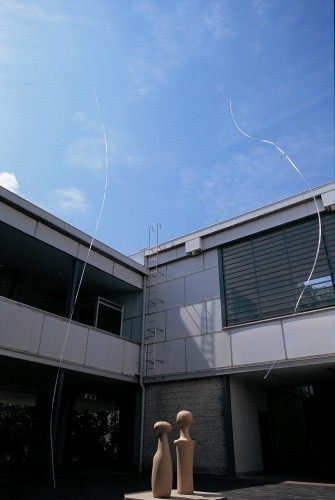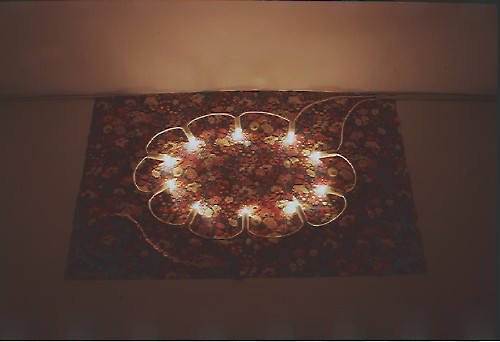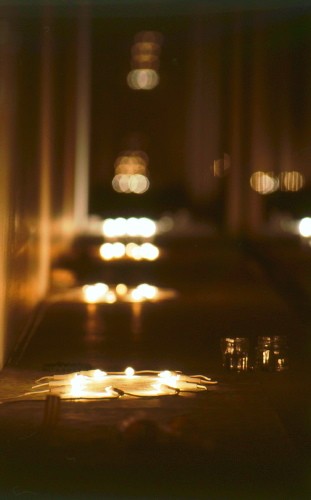Tout animal est dans le monde comme de l’eau à l’intérieur de l’eau
14 November 2009 – 24 January 2010
Museum of Modern Art, Kamakura
http://www.moma.pref.kanagawa.jp
by Shirasaka Yuri (Art writer)

The spirit 2009 (2006 -)
Photo Hatakeyama Naoya
The spirit – a work constructed from ribbons and suspended in midair – caresses in passing Isamu Noguchi’s sculpture Kokeshi, permanent exhibit in the museum courtyard. Two ribbons pull toward each other, and apart, tracing an arc. The simplest of pieces, but fine day or cloudy, the spirit offers a visage in constant flux. Wind may blow and rain pour, but the ribbons remain firmly attached, taking whatever the environment throws at them. Naito’s accompanying work the spirit (please be with me), with buttons in gaps in the Oya stone wall, seems to watch over proceedings.
Opened in 1951, the Kamakura branch of the museum, situated in the grounds of the Tsurugaoka Hachimangu shrine, became Japan’s first public modern art museum. While viewing Naito Rei’s offerings positioned inside and out around the Sakakura Junzo-designed structure, visitors can get a feel for the changing face of the museum over the decades. There is no suggested order for viewing the works. Cloth laid on the floor resembles the sea, and beyond an arc of beads, one can look out on the pond, taking in views of rippling water, migratory birds, fallen leaves, and worshippers on the opposite side.

What kind of Place was the Earth? 2009
Photo Hatakeyama Naoya
On a personal level the installation What kind of Place was the Earth? was particularly striking. Glass display cases on opposing walls contained small light bulbs, arranged, pulsing faintly, on delicate floral print fabric as if for a circle dance. Two glass jars of water placed on opposite sides of the glass evoke the real and virtual, forming a ‘waterway’ of sorts connecting this world and the next. Transparent balloons and a small, folded cloth in imperial purple complete a work that has the cheerful tenderness of a child offering flowers to tiny souls.
There are also glass cases that visitors can enter. Looking out from inside, I felt like my dead self observing the comings and goings of the street. Apparently however the artist’s intention was quite the opposite: the display case representing ‘life on Earth’ and the center aisle that which is ‘outside of life’ (the dead, beings not yet born, the spirit world and so on). The light represents celebration, illuminating the world of the living as the dead look on. It struck me that the center could be a path for souls, like the approach to a shrine.
On my third viewing, while inside the display case my heart suddenly skipped a beat. From a certain position, people approaching the case for a closer look seemed to vanish in the reflected light. I felt I now understood how it is to become a spirit, or to be born into the world of ‘life on Earth’. Birth sustaining death, and death sustaining birth, in turn. A show of respect for the labors of the people on the streets, concealed in commonplace materials; a dynamic space where viewer and work become one. I sensed a ‘Mother Art’ affirming things as, to quote the artist, ‘just what they are.’

What kind of Place was the Earth? 2009
Photo Hatakeyama Naoya
ART iT Interview: Naito Rei (2009)
ART iT Picks: Naito Rei: Tout animal est dans le monde comme de l’eau à l’intérieur de l’eau
